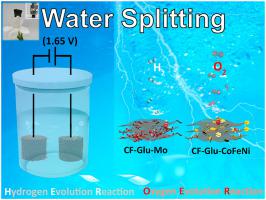Carbon ( IF 10.9 ) Pub Date : 2021-02-24 , DOI: 10.1016/j.carbon.2021.01.160 Junyang Ding , Li Zhong , Qi Huang , Yuanyuan Guo , Tingting Miao , Yue Hu , Jinjie Qian , Shaoming Huang

|
Herein, we present a stepwise approach for constructing 3-dimensional porous carbon foam pretreated via glutaraldehyde cross-linking and decorated with highly dispersed molybdenum carbide (CF-Glu-Mo) or Co-doped FeNi carbonate hydroxide (CF-Glu-CoFeNi), which is structurally derived from the initial chitosan hydrogel. The as-prepared CF-Glu-Mo and CF-Glu-CoFeNi can act as mono-functional electrocatalysts for hydrogen evolution reaction (HER) and oxygen evolution reaction (OER), respectively. In 1.0 M KOH, CF-Glu-Mo exhibits a small overpotential of 88 mV with a low Tafel slope of 56 mV dec−1 under the working condition of 10 mA cm−2 for HER, and CF-Glu-CoFeNi requires an overpotential of 290 mV for OER to reach a current density of 50 mA cm−2, accompanied by a low Tafel slope of 115 mV dec−1. In this case, these integrated electrodes derived from the robust interconnection between the electrocatalyst and the chitosan hydrogel derived carbon foam make the whole water decomposition behavior more direct and efficient, which is reasonably attributed to hierarchically porous nanostructures and intrinsically high conductivity. The full electrolyzer assembled with carbon cloth (CC) of CF-Glu-Mo/CC||CF-Glu-CoFeNi/CC can drive full alkaline water splitting by applying a voltage of 1.65 V at a catalytic current of 10 mA cm−2 for 24 h. Meanwhile, this work provides a feasible approach for the development of efficient water splitting electrocatalysts through the rational design and regulation of heterogeneous interfaces and nanostructures.
中文翻译:

壳聚糖水凝胶衍生的碳泡沫与典型的过渡金属催化剂,用于有效的水分解
在这里,我们提出了一种逐步的方法,该方法用于构造通过戊二醛交联进行预处理并用高度分散的碳化钼(CF-Glu-Mo)或共掺杂的FeNi碳酸碳氢氧化物(CF-Glu-CoFeNi)装饰的3维多孔碳泡沫,其结构上是从最初的壳聚糖水凝胶衍生而来的。所制得的CF-Glu-Mo和CF-Glu-CoFeNi可以分别用作氢析出反应(HER)和氧析出反应(OER)的单官能电催化剂。在1.0 M KOH中,CF-Glu-Mo在10 mA cm -2的工作条件下表现出88 mV的小过电位和56 mV dec -1的低Tafel斜率对于HER,CF-Glu-CoFeNi需要290 mV的过电势才能达到OER,以达到50 mA cm -2的电流密度,并伴随着115 mV dec -1的低Tafel斜率。在这种情况下,这些集成电极源自电催化剂和脱乙酰壳多糖水凝胶衍生的碳泡沫之间的牢固互连,从而使整个水的分解行为更加直接和有效,这可以合理地归因于分层的多孔纳米结构和本质上高的电导率。用CF-Glu-Mo / CC碳布(CC)组装的完整电解槽|| CF-Glu-CoFeNi / CC可以通过在10 mA cm -2的催化电流下施加1.65 V的电压来驱动碱性水的完全分解持续24小时。同时,这项工作通过合理设计和调节异质界面和纳米结构,为开发高效的水分解电催化剂提供了可行的方法。



























 京公网安备 11010802027423号
京公网安备 11010802027423号